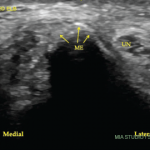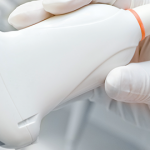Editor’s note: This is an excerpt from “Carpal Tunnel Syndrome,” by Joseph J. Biundo, MD, and Perry J. Rush, MD. To download the complete fact sheet, visit www.rheumatology.org and click on “Patient Resources” under “Popular Content.”
Carpal tunnel syndrome is possibly the most common nerve disorder experienced today. The carpal tunnel is located at the wrist on the palm side of the hand just beneath the skin surface (palmar surface). Eight small wrist bones form three sides of the tunnel, giving rise to the name carpal tunnel. The remaining side of the tunnel, the palmar surface, is composed of soft tissues, consisting mainly of a ligament called the transverse carpal ligament. This ligament stretches over the top of the tunnel.
The median nerve and nine flexor tendons to the fingers pass through the carpal tunnel. (Flexor tendons help flex or bend the fingers.) When this median nerve in the wrist is compressed (squeezed by swollen tissues, for example), it slows or blocks nerve impulses from traveling through the nerve. Because the median nerve provides muscle function and feeling in the hand, disabling the nerve results in symptoms ranging from mild occasional numbness to hand weakness, loss of feeling and loss of hand function.
Usually, carpal tunnel syndrome affects only one hand, but it can affect both at the same time, causing symptoms in the thumb and the index, middle, and adjacent half of the ring finger. In addition to numbness, those with the syndrome may experience tingling, pins-and-needles sensation, or burning of the hand, occasionally extending up to the forearm.
Frequently, symptoms surface in the morning upon awakening, or may cause waking during the night. Symptoms can occur with certain activities such as driving, holding a book, or other repetitive activity with the hands, especially those requiring prolonged grasping or flexing (bending) of the wrist. Hand functional activities, such as buttoning, may become difficult, and sufferers may drop things more easily. Individuals often shake their hands trying to obtain relief and may experience the sensation of swelling when, in fact, no swelling is present.
Because numbness and tingling may be mild and occur only periodically, many do not seek medical help. However, the disease can progress to more persistent numbness and burning. In some severe and chronic cases of carpal tunnel syndrome, loss of muscle mass occurs at the base of the thumb on the palm side of the hand. In these instances, especially in untreated cases, some weakness or impaired use of the hand as well as loss of sensation can occur with permanent nerve and muscle damage.
What Causes Carpal Tunnel Syndrome?
Metabolic carpal tunnel syndrome may occur in patients who are pregnant, overweight, or have various medical conditions including thyroid disease, diabetes, or arthritis, or injuries such as wrist fractures. Whether repetitive work activities cause carpal tunnel syndrome is still debated, but it is thought that some repetitive hand activities, especially those involving vibratory motion, can worsen the symptoms. Just as frequently, the syndrome occurs on its own.


